How Was Art Thought of in the 1700s America
American History Timeline 1700-1800
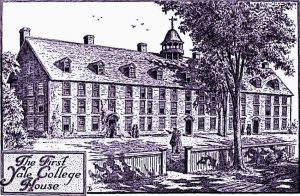
The First Yale College House American History
1701 – The foundations of Yale University are laid
In 1701, the Colony of Saybrook passed an human activity to establish a Collegiate School. Situated in modern-day Connecticutt, this schoolhouse eventually evolved to become one of the leading university of the world today, namely Yale University.
1702 – Queen Anne's War begins
In 1700, the king of Spain Charles 2 died. He had no heirs, so there was a dispute over who should succeed him as male monarch. This eventually led to a war in which the major European powers participated at i side or the other. Britain fought against France and Spain. The war spread to North America equally well in 1702 where British and French fought against each other.
1702 – New Jersey colonies are established
In 1702, the British Queen Anne established the majestic colony of New Jersey past combining the American provinces of Eastward Jersey and West Jersey.
1713 – Queen Anne'due south War ends
The British won the Queen Anne'south War and concluded it with a treaty in 1713. They also gained control of many new areas in Northward America including Acadia, Newfoundland, Hudson Bay and St. Kitts isle.
1715 – The Yamasee War takes identify
By 1715, the British had established many colonies in North America. They also took over many of the lands of the Native Americans who resented them.
This and many other factors led to the start of the Yamasee State of war. This state of war was fought betwixt British colonists of South Carolina at one side and a number of Native American tribes at the other side led by the Yamasee tribe. The Native Americans destroyed a number of settlements and killed a big number of colonists.
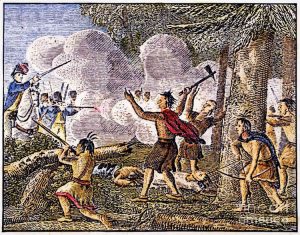
Yamasee War American American History Timeline
1717 – S Carolina wins the Yamasee War
At the start of the war, the British colonists in Southward Carolina suffered many setbacks. They lost many lives as well as settlements. Just slowly, they turned the war confronting the Yamasee tribe. Past 1717, the Yamasee were effectively defeated and the South Carolina colonists were victorious, bringing the war to an end.
1722 – Dummer's War begins
The Queen Anne's War concluded in 1713 with British victory. As part of the treaty, the French gave up several areas to the British. Some of these areas were originally occupied past Native American tribes, and then they didn't like the terms of the treaty.
Also, the British colonists started settling on the state belonging to these tribes which further angered them. This somewhen led to the start of a new war between British colonists and Native American tribes. This was known as the Dummer'due south War.
1725 – Battle of Pequawket takes identify
The Battle of Pequawket took identify every bit a role of the Dummer'due south War. In this boxing, a pocket-sized ground forces of British colonists was ambushed by a group of Pequawket warriors.
The battle took place in Maine. The British colonists suffered significant losses during this boxing equally xx of the 46 soldiers died. On the other side, the Pequawkey tribe also suffered many losses including their leader, Chief Paugus.
1729 – N and South Carolina go royal colonies
The Northward Carolina and South Carolina was originally established by independent British colonists. This meant that the government of the colonies was washed by these contained colonists. Simply people didn't similar their government and by 1729, the British king purchased the colonies from the colonists. These colonies now became a possession of the crown and straight came under the British dominion.
1750 – Britain passes Iron Act
The British parliament passed the Atomic number 26 Deed in 1750. This act eliminated the taxes paid by Britain on the iron imported from its American colonies. It as well said that the American colonies should non use atomic number 26 for product and export it in raw form to United kingdom.
The American colonies didn't like the human activity because it stopped them from established product facilities on their own country. It also reduced their profits from exporting iron. The Iron Act was one of the master causes that angered the Americans and led to the American Revolution.
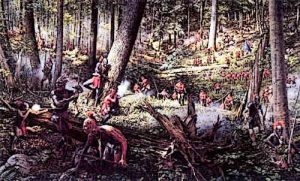
In 1754, the French and Indian War began. This war was fought between British colonies in Northward America and the French colonies every bit well as their allies.
1754 – French and Indian War begins
In 1754, the French and Indian War began. This war was fought between British colonies in North America and the French colonies as well equally their allies.
At the same fourth dimension, the 7 Years' State of war was being fought in Europe. The French and Indian War began is considered a smaller part of the Vii Years' War. George Washington was a fellow of 22 at the time and he participated in this war as part of the British militia from Virginia.
The war was mainly fought for the command of the Ohio River Valley. The French initially won many victories. Then in 1757, more soldiers arrived from Britain and the British colonists were able to defeat the French and their Indian allies. As a upshot, they gained command of the Ohio River Valley.
1763 – Pontiac's State of war begins
The Native American tribes in the Ohio River Valley didn't appreciate British victory in the French and Indian War. They didn't like the fact that the British colonists and soldiers stayed on in the Valley. This eventually led to a new war by a Native American main named Pontiac.
The state of war began in 1763 and connected until 1763. During this time, the Native American warriors killed a large number of British soldiers and white settlers. The British as well killed a large number of Native Americans. In the end, both sides agreed to resolve the thing through negotiations and the Native Americans left the lands claimed by the British.
1763 – King George II issues the Majestic Announcement of 1763
After the French and Indian War had ended, the King George II of United kingdom issued a Regal Proclamation. This proclamation was aimed at protecting the rights of the Native Americans.
It said that the colonists should not settle on the lands west of the Appalachian Mountains. The colonists didn't similar this. Some of them had been requite land grants in that area, and this mean't the loss of these grants. This angered the colonists and became 1 of the reasons why colonists eventually rebelled confronting the British rule.
1764 – British Parliament passes the Sugar Human action
In 1764, the British Parliament passed the Sugar Human action. Back in 1733, the parliament had passed the Molasses Deed. This act imposed new taxes on molasses but the act was never strictly enforced.
In the Sugar Deed, the parliament reduced the taxes of the Molasses Act just said that the tax volition now be strictly enforced. This took place at a fourth dimension when the economic conditions of Northward American colonies were not good. So the colonists were angry about this Act.
1765 – British Parliament passes the Stamp Human action
By 1765, a big number of British soldiers were stationed in N American colonies. These soldiers required food, housing, and a large amount of money for their wages.
The British parliament wanted to collect this coin from the colonists. So information technology imposed a new tax through the Stamp Deed. The Act said that if anyone wanted to print any cloth in N American colonies, they should practise so on the embossed papers imported from London.
These papers were expensive, so colonists had to pay more money. This angered them and they started protesting against the parliament. Stamp sellers and distributors on North America were threatened by the colonists. This Act became 1 of the principal causes of the American Revolution.
1767 – Townshend Acts pb to riots and protests
Every bit office of its efforts to impose taxes and enhance more money from the colonies, the British authorities imposed a number of new taxes in 1767. These were collectively known as the Townshend Acts.
Through these acts, the government imposed new duties on glass, tea, lead, newspaper and other items imported to the American colonies. This angered the colonists and American merchants started boycotting British goods. The greatest unrest took place in Boston which was one of the primary economic centers at the time.
1770 – Boston Massacre takes place
In 1768, British government ordered that British soldiers should be stationed in Boston. This was because nigh of the protests against new taxes imposed by the British authorities took place in Boston.
In 1770, a group of protestors gathered around 8 British soldiers. They hurled abuse at the soldiers and threatened them with clubs and stones. The soldiers opened fire and killed three people, with some other two later dying of wounds. This became known as the incident of Boston Massacre.
1773 – British Parliament passes the Tea Act
In 1773, the British Parliament passed the Tea Human action. This Act didn't impose any new taxes but it granted complete monopoly over the tea trade in the Americas to the British East India Company.
At the fourth dimension, more than 80% of the tea consumed in American colonies was smuggled, to avoid the loftier amount of import duties. The Tea Human activity aimed to terminate this and help out the East India Company at the aforementioned time which was in debt. The Act was very unpopular with the colonists and lead to the incident of the Boston Tea Party.
1773 – Boston Tea Party takes identify
The Boston Tea Party was a protest launched past an organization known as Sons of Liberty. This organization was formed by the 13 American colonies to protest against the economic policies of Britain towards the colonies.
After the British Parliament passed the Tea Human action in 1773, the Sons of Liberty strongly protested against the Human activity. As office of their protests, they boarded British ships conveying tea in Dec 1773 and destroyed the shipment by throwing the tea chests into the harbor. This became known every bit the Boston Tea Party.
1774 – Intolerable Acts anger the colonists
The Boston Tea Party greatly angered the British Parliament. To punish Boston and the colony of Massachusetts, the parliament passed a number of new Acts. These were later known every bit Intolerable Acts.
These Acts closed the port of Boston to all economic activity, took away the political rights of Massachusetts, and imposed other castigating measures. This was seen as coercion by the colonists and became a major reason for the American Revolution.
1774 – Offset Continental Congress convenes
In 1774, the Beginning Continental Congress took identify. This was a meeting of the delegates from the Thirteen Colonies. The coming together was convened to discuss the Intolerable Acts passed past the British Parliament.
It agreed on a fix of rights and grievances which were shared with the King George III through a petition. The Congress as well discussed the establishment of local militias for the colonies. It was decided that if the King didn't respond to their petition, a second Continental Congress would take place the next year.
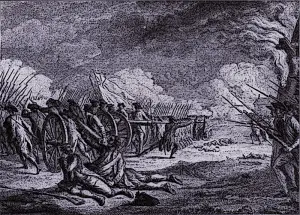
Battle of Lexington 1775
1775 – Battles of Lexington and Hold are fought
The Battles of Lexington and Concord were the first armed engagement between British forces and the American revolutionaries. In 1774, British government had dissolved the Massachusetts colonial government but the colonial regime continued to operate on a conditional footing. It likewise overlooked the creation and preparation of a militia forcefulness.
In April 1775, British forces were stationed mainly in Boston. A portion of these forces marched to Lexington, Hold and other towns with the intention of destroying militia supplies.
They were confronted by the militia men and the showtime shots of the American Revolution were fired. The militia men kept attacking the British force during its search for supplies and then during its march dorsum to Boston. So the militia army laid siege to Boston.
1775 – Battle of Bunker Hill results in a costly British victory
The Battle of Bunker Hill took identify as part of the Siege of Boston during the American Revolutionary War. The British decided to occupy the hills surrounding the metropolis of Boston.
The colonial forces learned about this program and occupied the Breed'south Hill with the intent of opposing the British accelerate. When the British tried to occupy the hill, the colonial forces took them by surprise and attacked them.
In the end, British troops were able to gain control of the loma but they had to suffer astringent losses. In all, the British suffered around 1,000 casualties while the colonial forces suffered about 450 casualties.
1775 – 2nd Continental Congress convenes
The 2nd Continental Congress took place in 1775. In this congress, the delegates from xiii colonies discussed the ongoing American Revolution. The Congress finer became the de facto regime of the colonies at state of war. It determined the strategy of the state of war also as the upshot of raising and paying armies, and establishing treaties with others on behalf of the colonies.
1776 – Declaration of Independence is adopted by the Second Continental Congress
The Declaration of Independence was a very important declaration adopted by the 2d Continental Congress in 1776. This declaration said that the thirteen American colonies were no longer under British rule and considered themselves as contained entities.
1777 – Winter at Valley Forge shape upward the Continental Regular army
In 1777, Full general George Washington and the Continental Ground forces camped at Valley Forge during the winters. They didn't have enough provisions and supplies. Nearly 2500 men died due to the poor weather.
But the time at Valley Forge gave the Continental Ground forces to train well and get ameliorate as an army overall. When the ground forces emerged from Valley Forge after the winters, information technology was prepare to fight the British more effectively.
1777 – Battles of Saratoga lead to major American victory
In 1777, ii battles were fought betwixt the American and British forces in Saratoga Canton, New York. These were known equally the Offset Boxing of Saratoga and the 2nd Battle of Saratoga. In the beginning battle, British were victorious simply they couldn't break through American lines to achieve their actual objective.
In the 2d battle, the American ground forces was decisively victorious. The whole British army was surrounded and forced to surrender. This was an of import event of the Revolutionary State of war considering the British defeat convinced French republic to form an alliance with America.
1781 – Siege of Yorktown results in decisive British surrender
During 1781, a number of battles were fought betwixt American and British forces in Virginia. In many of these battles, French troops fought aslope American armies.
Most of these engagements resulted in British defeats, and the British troops were eventually forced to have refuge in Yorktown. They had hoped that they would receive reinforcements or help from the sea. Only the articulation American and French forces laid a state and sea siege of Yorktown.
Ultimately, the British regular army was forced to give up and nearly 7500 British troops were captured. This effectively marked the finish of the Revolutionary War as the Give up at Yorktown became the last major engagement of the War.
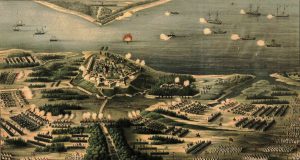
Siege of Yorktown 1862 Map
1783 – Treaty of Paris ends the American War of Independence
With the Surrender at Yorktown, the British realized that they could no longer win the war. And then they decided to sue for peace. These efforts led to the Treaty of Paris signed in 1783.
Co-ordinate to this treaty, Corking Uk officially accepted its defeat and recognized the independence of the The states of America. The treaty also stated that the western purlieus of the U.s. was the Mississippi River, although the newly born nation soon expanded beyond this boundary.
1787 – Constitution of the United States is composed at the Constitutional Convention
The Constitutional Convention took place from May to September, 1787. This was an effect where delegates from all the 13 Colonies participated. They came together to hash out what sort of government they should create now that they were gratuitous from the British rule. They besides discussed how the states will exist under this government and how independent volition be the states.
Some other of import matter they discussed was the powers of the President of United States. George Washington, who had led United States to victory in the Revolutionary War, presided over this convention.
1787 – Publication of Federalist Papers begins
Federalist Papers were essays and manufactures which explained the new Constitution of the United states. These were written in society to gain the support of the people and united states of america in favor of the new constitution. The main authors of these papers were Alexander Hamilton, James Madison and John Jay, all three among the Founding Fathers of USA.
In total, they published 85 manufactures and essays between Oct 1787 and April 1788. These papers became very important in understanding the constitution of Usa.
1791 – Bill of Rights
Some of the states didn't like the new constitution. They wanted to change it and agreed to vote in its favor only if the constitution would be amended before long later.
These amendments took place in 1791. They were collectively known every bit the Pecker of Rights and comprised of a total of 10 amendments. The amendments were approved in 1789 past the Congress. Just it needed to exist approved by at to the lowest degree 10 states in society to become a part of the U.S. Constitution.
In 1791, Virginia became the tenth state to ratify the amendments which then became a office of the constitution. These amendments were mainly concerned with basic rights of U.S. citizens such as the correct to assembly, freedom of religion, liberty of spoken language and legal rights.
1794 – Whiskey Rebellion
After the American Revolution, virtually all the states in USA had a big debt. To repay this debt, the federal regime decided to impose a whiskey tax. This tax was imposed on the producers of whiskey. It adversely affected the small producers in Virginia and Pennsylvania who started protesting against the revenue enhancement.
Soon after the revenue enhancement was imposed, protests spread all over Pennsylvania where people refused to pay the tax and intimidated the officials who came to collect it. The protests were so widespread that President George Washington had to send in a militia. In the stop, the tax was repealed.
1800 – The White Business firm
The construction of the White Firm began in 1790s. It was until 1800 that an American President came to alive in it for the first time. Although it was still unfinished at the time, President John Adams and his wife Abigail Adams took upwardly residence in the White House. Thus began the long tradition of White House becoming the seat of U.Due south. presidents.
Source: https://american-history.net/american-history-timeline/american-history-timeline-1700-1800/
Post a Comment for "How Was Art Thought of in the 1700s America"